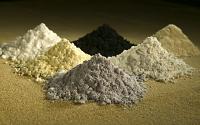Sea holds treasure trove of rare-earth elements

The world's insatiable demand for the rare-earth elements needed to make almost all technological gadgets could one day be partially met by sea-floor mining, hints an assessment of the Pacific Ocean's resources. But accessing the treasure trove of key elements on the ocean floor will be very expensive and potentially harmful to sea-floor ecology.
Quicktabs: News
Kato says that he doesn't know whether the resource is commercially viable. "I'm a geoscientist, not an economist," he notes.
But Gareth Hatch, an industry analyst and founder of the Technology Metals Research consultancy in Carpentersville, Illinois, is sceptical. "People talk about mining on the asteroids or the Moon. This isn't that hard, but it's similar," says Hatch. Current on-land mines, and sites picked out for future mines, have rare-earth concentrations of about 3–10%, he points out. The much lower concentrations at the Chinese clay mine mentioned by Kato and his colleagues are only economically viable because the material is much easier to access than it would be in hard rock. That's not true for mud located below 4 or 5 kilometres of water, which would require expensive ship time and equipment to pull up. "There are better options," he says.
Craig Smith, an oceanographer at the University of Hawaii at Manoa, notes that companies are exploring the idea of mining manganese nodules from the sea floor to exploit their commercially-valuable contents, including copper and nickel as well as rare earths. Commercial mining of nodules is "probably a decade away", says Smith. Ocean mud could prove another possible source of the increasingly valuable elements.
It has long been known that the ocean might provide a wealth of rare earths. Sea-floor hydrothermal vents pump out rare-earth elements dissolved in their hot fluids. And these elements and others accumulate in potato-sized lumps, called manganese nodules, on the sea floor. The elements also build up in sea-floor mud; but only a few spot measures of this source of rare-earth elements have previously been made.
Kato and his colleagues set out to perform a widespread assessment of this possible resource. They looked at 2,000 samples of sediments taken from 78 sites around the Pacific, and found rare-earth concentrations as high as 0.2% of the mud in the eastern South Pacific, and 0.1% near Hawaii. That might not sound like much, but those concentrations are as high as or higher than those at one clay mine currently in operation in China, they point out. And the deposits are particularly rich in heavy rare-earth elements — the rarer and more expensive metals.
Some of the deposits are more than 70 metres thick. The authors estimate that an area of 1 square kilometre around a hotspot near Hawaii could hold 25,000 tonnes of rare earths. Overall, they say, the ocean floor might hold more than the 110 million tonnes of rare earths estimated to be buried on land.
